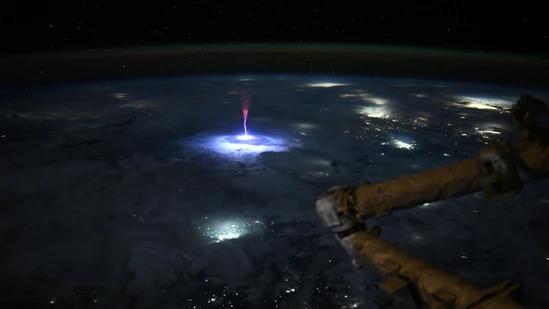
NASA Astronaut Captures Rare ‘Sprite’ Lightning Over US & Mexico
On a rare occasion, NASA astronaut Nichole Ayers got the chance to capture a breathtaking phenomenon known as ‘sprite’ lightning from the International Space Station (ISS). While orbiting above the United States and Mexico, Ayers snapped a stunning photo of this rare atmospheric event. Sprites are a type of Transient Luminous Event (TLE), characterized by brief bursts of light that occur above thunderstorms.
Ayers’ photo shows a vibrant, glowing sprite hovering above the clouds, illuminated by the ISS’s bright lights. This unique capture has garnered significant attention from scientists and enthusiasts alike, who are eager to learn more about these enigmatic events. According to Ayers, scientists can use photos like hers to better understand the relationship between TLEs and thunderstorms.
But what exactly are sprites? Sprites are a type of upper-atmospheric lightning that occurs when a powerful thunderstorm excites the atmosphere, causing electrons to be released. This phenomenon is often referred to as a “red sprite” due to its reddish hue. Sprites are relatively rare, as they require specific conditions to occur, including a strong thunderstorm and a clear path for the electrons to follow.
Ayers’ photo is a testament to the incredible capabilities of the ISS, which has been continuously occupied by astronauts since 2000. The station’s unique vantage point, orbiting about 250 miles above the Earth’s surface, provides scientists with a bird’s-eye view of our planet. This allows them to study a wide range of phenomena, from the effects of climate change to the behavior of extreme weather events.
The ISS is equipped with a range of scientific instruments and cameras, which are used to capture stunning images and data. Astronauts on board the station often share their photos and experiences with the public, providing a unique perspective on the wonders of our planet.
Ayers’ photo is not the first time a sprite has been captured from space. In the past, astronauts have captured images of sprites and other TLEs, including “blue jets” and “cloud-to-cloud lightning.” These events are often fleeting and difficult to capture, making Ayers’ photo all the more remarkable.
Scientists are eager to study sprites and other TLEs because they can provide valuable insights into the Earth’s atmosphere and the processes that govern it. By analyzing these events, researchers can better understand the complex interactions between the atmosphere, oceans, and land.
Ayers’ photo is a reminder of the incredible wonders that can be found in our planet’s atmosphere. From the majestic beauty of thunderstorms to the fleeting bursts of lightning, there is always more to discover and learn about our world.
Source:






